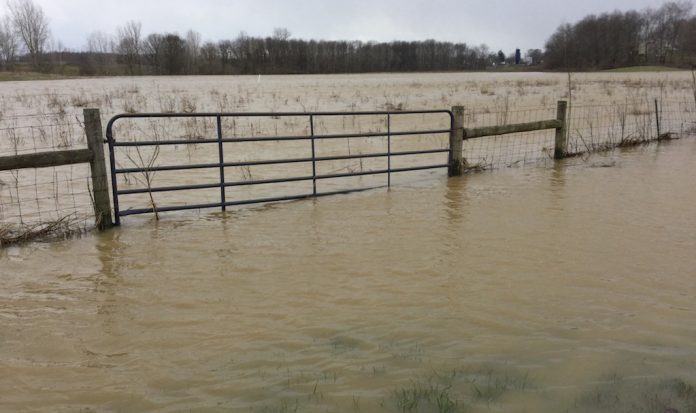Did you know we have the same amount of water on earth now as there was when the earth was formed?
It sure doesn’t feel that way this summer with all the rain and flooding in our area. Average yearly rainfall for most of Ohio is 38 inches.
From July 2018 to July 2019, our area received 50 to 60 inches of rain according to the National Weather Service. This makes east-central Ohio as much as 20 inches above normal for the year.
This wet weather pattern has presented many flooding issues around the county: roads, crops and fields, basements, driveways and yards.
Water draining off the landscape always seeks the lowest point.
Changing the flow of water in a manner that causes damage to an upstream or downstream neighbor may result in legal liabilities for those damages.
Ohio laws governing water rights and drainage are complex since they have been determined by case law, which is constantly evolving.
Serious disputes between landowners are often settled in court on a case-by-case basis. The laws are not easily summarized.
However, most people who work in the area of drainage or water management would agree that the following principles apply to individual landowners:
– A landowner is entitled to the reasonable use of the water that flows across his/her land, as long as the water is returned to its natural watercourse.
This includes ponding water behind a dam for personal use or making drainage improvements to protect structures;
– A landowner is generally required to accept the water that flows onto his/her property in a natural watercourse, so long as no additional water from another watershed has been added to such flow;
– A landowner is generally obligated to outlet a natural watercourse onto his/her downstream neighbor at the same point the water left the property prior to any development of the site;
– Put more simply, water should enter and leave your property where it did prior to any construction activities.
Oversight
At this time, there is no government agency that has any authority to issue orders or otherwise resolve conflicts over water rights or drainage problems between neighbors.
The exception may be the few cities that have drainage or stormwater ordinances.
The Coshocton Soil and Water Conservation District office has been overwhelmed with drainage issues the past several months.
Our technicians go out and look at the area, pinpoint potential issues and suggest a solution, but we have little legal room to enforce what happens next.
That being said, we are here to help as best we can, so call our office, or your local soil and water conservation district office, for assistance.
Solving drainage problems
If you are considering making a drainage complaint, keep the following things in mind:
– If your complaint is with your neighbor, talk to your neighbor first;
– If you go to an SWCD with a drainage complaint, depending on the situation, these are a few of the questions we typically ask:
How long have you lived at the property? Is there tile and is it in good condition? Are there blowholes in your yard? Is there a functioning outlet on your property?
– Technicians come out by appointment, look at the area and make suggestions based on what they see.
The suggestions can range from a change in present management of the site, to a full engineering plan for a drainage practice.
The most common thing our technicians do is an Inventory and Evaluation report of the site where present site conditions and issues are described, followed by proposed solutions.
Work together
It is important to keep in mind that we are a voluntary agency and cannot force anyone to do anything, or stop doing anything as it pertains to drainage.
Often, solving residential drainage issues will take buy-in from several adjoining property owners.
This is the case with a surprising number of agricultural drainage issues as well.
This presents a large obstacle for coming up with long-term solutions on most drainage projects that our office is involved in, because when property lines need to be crossed, each landowner has an equal say in what gets done.
One thing that we can all agree on is that the wet weather this past year has affected everyone in one way or another.
Unfortunately, landowners with existing drainage issues have borne the brunt of this frustrating weather pattern.
Life is like the river, sometimes it sweeps you gently along and sometimes the rapids come out of nowhere.
Call your local soil and water conservation district office to discuss your drainage issues.













